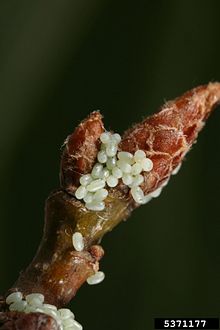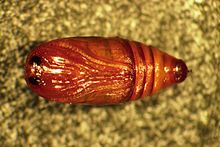Little frost wrench
| Little frost wrench | ||||||||||||
|---|---|---|---|---|---|---|---|---|---|---|---|---|

Lesser Frostworm ( Operophtera brumata ), male |
||||||||||||
| Systematics | ||||||||||||
|
||||||||||||
| Scientific name | ||||||||||||
| Operophtera brumata | ||||||||||||
| ( Linnaeus , 1758) |
The small winter moth ( Operophtera brumata ) is a butterfly from the family of the tensioner (Geometridae). Like the great frost wrench, it belongs to the forest pests.
features
The animals show a pronounced sexual dimorphism . The males have a wingspan of 20 to 25 millimeters, the front wings are from gray-yellow to beige-brown, sometimes even slightly reddish in color. The transverse lines are brownish, mostly indistinct, the fields in between are often darkened in the form of bands, the fringes yellowish. The hind wings are pale yellow to gray in color. The antennae are short and finely haired. The flightless female, which can only move forward, has a brownish-gray body color. It has rudimentary wing stubs that are brown to gray in color and have dark ribbons. As with some other autumn and winter species, the mouthparts of the moths (proboscis) are stunted in Operophtera brumata ; the adults cannot eat and have a lifespan of only a few days.
Similar species
- Beech Frostworm ( Operophtera fagata ); Slightly larger and on average lighter than Operophtera brumata . Since both species occur side by side and are very variable in color, a differentiation is only possible through a genital examination .
distribution
The little frost wrench is common in northern and central Europe. In the south it is distributed as far as northern Italy, in the east from the Caucasus to the Baltic States .
Way of life
The moths hatch from the pupae in autumn, often only after the first frost. The males swarm in forests, orchards and parks at dusk and at night. The females climb with their six strong legs from the ground up the trunks of the host trees, where mating takes place. The overwintering eggs are laid in cracks in the bark. The larvae then hatch in spring at the time the leaves shoot, which, depending on the local climate, falls between March and May. Unlike the caterpillars of the Great Frostworm, they spin a weak web in their buds and between young leaves, which are their preferred food, which is supposed to protect them from predators. Pupation takes place in or on the ground.
Since the flightless females only have a limited radius of action and cannot be carried by the males in flight during mating (although this legend appears again and again in daily newspapers and in non-scientific literature), the spread of the species is reserved for the young caterpillars. The newly hatched egg caterpillars spin threads and can be displaced by the wind on them, similar to how the young spiders practice in the so-called Indian summer . This explains the occurrence of frost moth caterpillars on high-rise balconies, on islands in lakes and rivers and generally in places where the species had not previously appeared.
Food and harmful effects
The caterpillars of the small frost moth are polyphagous and can cause considerable damage to their host trees. Sometimes they only leave the thicker leaf veins and stems. Occasionally, an entire tree is corroded. Numerous hardwoods serve as host species, including oak , beech , hornbeam , maple and many others, as well as fruit trees, to which the caterpillars can cause great damage.
In fruit growing, an infestation with 3–4 caterpillars per 100 flower clusters is considered a damage threshold .
To protect fruit trees, cuffs coated with glue, so-called rings of glue, can be placed around the trunks , on which the females get caught . Since the dying animals then often place their entire egg supply on the glue ring, this control method is only used if the glue ring is removed and burned in good time before the caterpillars hatch. However, if there are other infested trees within a few kilometers, then sooner or later a new settlement by wind-drifted young caterpillars can be expected.
Chemical control with the insecticides tebufenozide or indoxacarb is less labor-intensive . Neonicotinoids are also effective but have no indication .
Flight time
The little frost wrench flies in one generation from mid-October to the end of December. The caterpillars are found from April to June.
swell
literature
- Günter Ebert (Ed.): The butterflies of Baden-Württemberg Volume 8, Nachtfalter VI (Spanner (Geometridae) 1st part), Ulmer Verlag Stuttgart 2001, ISBN 3-800-13497-7
- Wolfgang Schwenke (Hrsg.) Among others: The forest pests of Europe. Volume 3: Butterflies . Parey, Hamburg and Berlin 1978, ISBN 3-490-11316-0
- Fritz Schwerdtfeger : The forest diseases. Textbook of forest pathology and forest protection . 4th, revised edition. Parey, Hamburg and Berlin 1981, ISBN 3-490-09116-7
- Manfred Koch , Wolfgang Heinicke: We identify butterflies. 3. Edition. Neumann, Radebeul 1991, ISBN 3-7402-0092-8 .
- Christian Koppel, Axel Steiner: A winged female of Operophtera brumata (Linnaeus, 1758): A case of atavism (Lepidoptera, Geometridae) on August 20, 1994 Atalanta (December 1994) 25 (3/4): 567-569, Würzburg, ISSN 0171-0079 , PDF (811 kB) on ZOBODAT
Web links
- Operophtera brumata (L., 1758) Small Frostworm
- Operophthera brumata (L.) - Kleiner Frostspanner, Winter Moth ( Memento from July 25, 2008 in the Internet Archive )
- Operophtera brumata LINNAEUS, 1758 (Kleiner Frostspanner) ( Memento from July 2, 2007 in the Internet Archive )
- Operophtera brumata (LINNAEUS, 1758) - Kleiner Frostspanner taxonomy and photos
- Moths and Butterflies of Europe and North Africa (English)
- Operophtera brumata in Fauna Europaea
Individual evidence
- ↑ a b U. Harzer, D. Metzlaff, A. Orth: Recommended products and notes on plant protection in stone fruit 2015 . In: fruit growing . No. 2 , 2015, p. 88-89 .
- ↑ Manfred Koch, Wolfgang Heinicke, Bernd Müller: We determine butterflies. Volume 4: Spanner. 2nd, improved and enlarged edition. Neumann, Leipzig / Radebeul 1976, DNB 780451570 , p. 98f.



